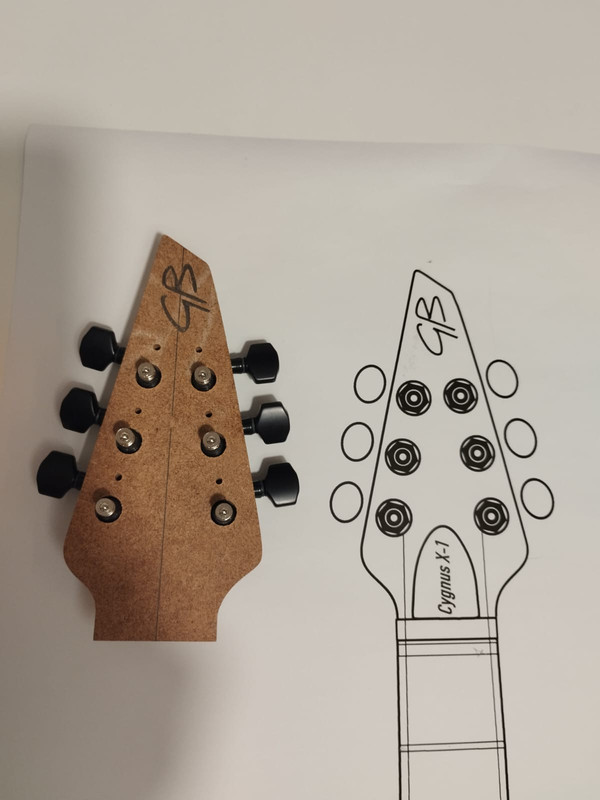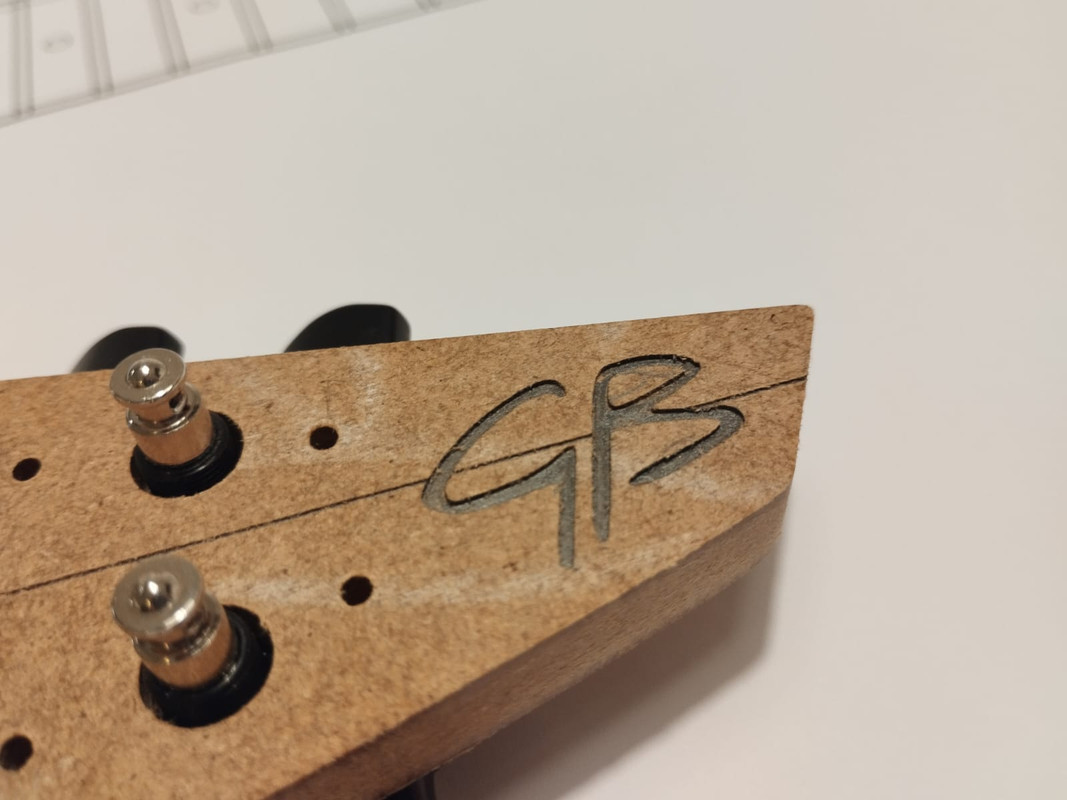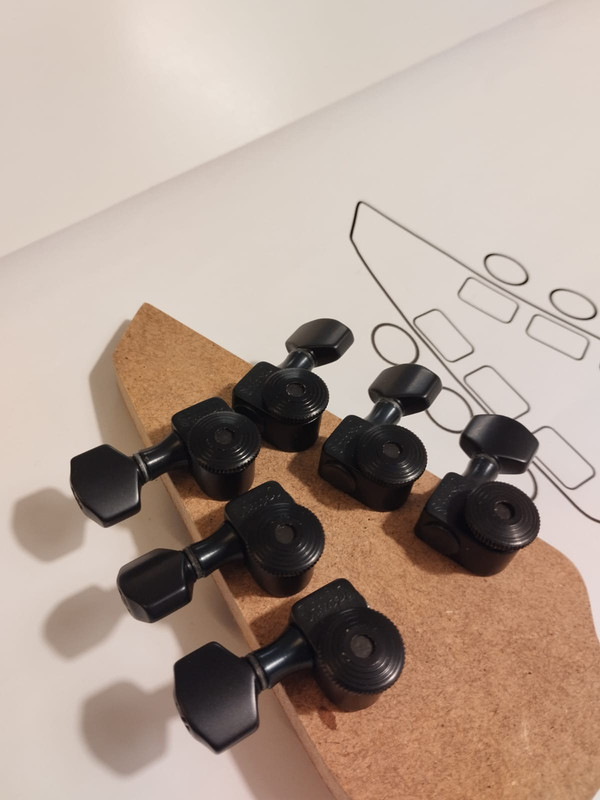gerinski
Apprentice Shielder
 
Posts: 45
Likes: 11
|
Post by gerinski on Jul 13, 2023 17:03:49 GMT -5
Hi all, I opened a thread in the "Wiring" forum regarding a project I'm currently developing for building my own self-designed solid body guitar. Thanks for helping me there. Here I want to share more of my (provisional) ideas to see if more experienced members can help me further. I have very little knowledge about guitar building (never built one) and I have not yet decided whether I will ask a luthier to build it (most probable option) or if I will dare to try building it myself together with a friend who knows quite a lot about working with wood (he's a cabinetmaker) but also has zero experience building guitars. Below you can see a couple of drawings showing how the guitar is intended to look. I own a '93 Carvin DC-135 which I like in many aspects so my custom axe would share quite a few things with it. It's a neck-through superstrat HSS, 24 frets, 25.00"" scale, Floyd Rose, Sperzel locking machine heads, 6 in-line tuners at the top (Strat style), simple electronics 3x toggle switches for each PU On/Off + 1 Volume + 1 Tone. I feel that the Carvin is a pretty good guitar so the objective is, of course, that my custom guitar has to be at least as good as, or hopefully better than the Carvin. Otherwise I will end up playing the Carvin and obviously that's not the point, I should end up playing my custom guitar and keeping the Carvin as a backup guitar. So it needs to be a high quality guitar. I'm calling my custom guitar the "Cygnus X-1". Cygnus X-1 was the first black hole discovered, and I like a lot physics and astronomy, so it fits. It's also a song by Rush, one of my favourite bands, so it fits too. And since it's going to be the first guitar I design, "X-1" also fits. So there's a triple fit with this name :-) So far what I have in mind: - Neck-through construction, same "neck joint" shape as the Carvin - 25.00" scale - 24 frets, same size as the Carvin - Neck width, profile and fretboard radius (12") same as the Carvin - Frets material: I welcome advice, in principle stainless steel? - Zero fret - Graphite nut - 3 + 3 headstock - Sperzel Trim-Lock machine heads (no locking bar behind nut) - Floyd Rose tremolo bridge (might be a Schaller or Gotoh which are cheaper) - Neck-through wood: I welcome advice, in principle rock maple? - Body sides wood: I welcome advice (poplar in the Carvin) - Fretboard wood: I welcome advice, in principle ebony - Round position markers on fretboard (1 - 2 - 3, Brian May style) (No fancy markers, I like sober) - Position markers on fretboard top (1 - 2 - 3, round) - HSH, Bridge pu: in principle DiMarzio Evolution Bridge - Middle pu: in principle either DiMarzio SDS-1 or DiMarzio ISCV2 (advice welcome) - Neck pu: in principle DiMarzio Evolution Neck (so basically same pu's as the Ibanez JEM) - 3 toggle switches: B = 3 position Off/S/HB, M = 2 position Off/On, N = 3 position Off/S/HB - 1 Volume + 1 Tone - Finish: Translucent medium grey (body + neck + headstock), all hardware in black - Gloss: I accept advice, in principle polyurethane  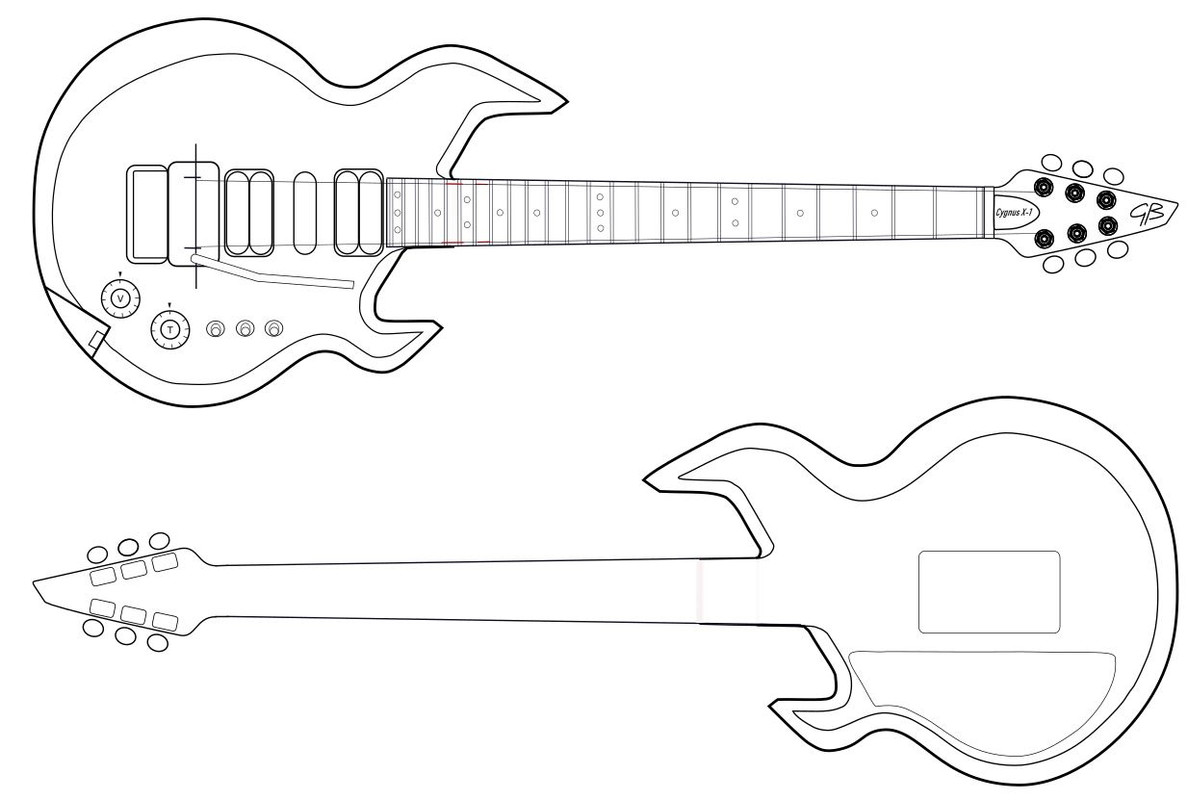 |
|
|
|
Post by newey on Jul 13, 2023 20:21:37 GMT -5
I'm sure others can give more specific advice. Just a few points, by way of first impressions. If it's a neck-through design with a translucent finish, the wood of the neck-thru portion will never exactly match the wood of the wings, and you'll see the difference through the finish. That's not necessarily a bad thing, many guitar makers use different contrasting woods for the neck blank and the wings to emphasize the different woods. Alembic has done that sort of thing for years, it can look very beautiful. But you should consider how different woods might look when seen through the grey finish. Once you decide on the wood types, it might be wise to glue a couple of small pieces of the different woods together and spray them with the color you are going to use, as a test, so you can get an idea of how it will look. If you hire a pro luthier, you can pretty much give him your wish list- and he'll give you a price, of course. If, however, it is to be built by you with the help of your friend you can simplify things considerably (and perhaps ensure that you remain friends through this project and beyond . . .) by purchasing a neck blank. The neck is the hardest part to get right- and it has to be right. If you can find one for sale that fits your needs, you'll greatly simplify the project. If the "off the shelf" choices don't suit your needs, there are also people who will make one to your specifications, like these guys at alloy guitars. This is in no way an endorsement of that shop, I just pulled them up in a google search as an example. I'm sure there are others. The design looks nice. I question the cut-out for the jack, though. The triangle cut-out, IMO, detracts from the curves of the guitar body. Something like that might look better on a more angular guitar body like a Flying V. I also think that the area where the material is being left at the rear of the body, sort of like a flange behind the jack, is likely to be a weak spot- the first thing to crack or break if the guitar falls off a stand or whatever. Why not just use a side jack with either an LP or Tele style jackplate? Just my 2¢. |
|
|
|
Post by gckelloch on Jul 13, 2023 23:21:52 GMT -5
To add to newey's tips: tests have shown that bolt-on necks actually have more sustain. The way the high-end dies off slower can make it sound like there's less sustain, but the note fundamentals actually last longer. Neck-thru's tend to have the least-- possibly because there's more neck surface area to be damped by the body. Of course, it all matters less the more rigid and dense is the wood. I recently had an S-type hartail body made of a Black Walnut center and Roasted-Poplar wings. The sustain and tonal balance is great. Maybe a tad more upper-mids and tighter bass than African mahogany. Not at all shrill, but a more full-sounding midrange. Black Walnut can be pretty heavy. The RP wings bring the weight down to a decent 4.2lbs. Body thickness matters to a degree. I'd want the centerpiece to be at least as thick as mine. It's 1-5/8" because he didn't have 1-3/4" RP, but the Walnut is dense enough so there's plenty of low end.
The guitar is nicely balanced at ~7.6 lbs. I have a Wenge neck on it, but I don't recommend it. It's too bright with the Stainless frest, yet missing something in the midrange. Black Walnut with an Ebony (or the like) FB might be very nice if you're not set on Maple. The Walnut should sound a bit warmer and may even have better note sustain. Keep in mind: the original Maple neck Fenders had a single -action truss rod. That allows the neck to flex more and absorb more attack than the dual-action rods. Walnut with a DA rod would absorb vibration more like Maple with a SA rod. Walnut is also stronger than African Mahogany, and very stable. This is all very general. Wood can be unpredictable, and weak spots sap sustain. One trick I do with all my bolt-ons to increase coupling force and reduce body surface area damping is to chisel out the center of the neck pocket to ~1cm around the edges and only ~1mm deep. It can keep the neck from shifting as well. I notice better sustain with stronger lows and maybe more extended highs.
For your body design, you might instead try an upward-facing Strat jack on the rear. That would work just fine with a straight or L plug and the cable run through the strap. I'd also think about moving the knee rest forward so it balances better when sitting.
|
|
gerinski
Apprentice Shielder
 
Posts: 45
Likes: 11
|
Post by gerinski on Jul 14, 2023 2:58:55 GMT -5
Thanks newey and gckelloch!
First of all I should probably clarify that I'm not a pro player, not even a high-level amateur, I play only for fun with a band of friends.
The choice of neck-through is more of an aesthetics and "nice feeling" sort of thing. I really like how my neck-through Carvin looks and feels. I am aware that a bolt-on simplifies things, but if the difference in tone or sustain is really subtle I doubt that I will ever notice it. At any rate I welcome and will take your comments into consideration.
Thanks also for the advice regarding the woods.
Regading the output jack, I reckon your comments, it's only a stlyistic choice aimed at having some visible personal detail, something different from the norm. And to have the jack and cable in a more "protected" position and facing to the strap button. But indeed it may leave that part of the body too weak. Perhaps using a Strat style jackplate facing to the strap button, possibly in the back, could be a better choice. I will re-think about it. Eventually I may have to go the standard way, an LP / Tele jackplate and forget about this fancy detail.
Finally regarding the knee rest, on the top drawing the guitar shape is superimposed on a Strat shape (in blue). As you can see the knee rest is not that much displaced with respect to the Strat. Another thing which becomes clear from the shapes superimposition is that my design would have quite much less wood than the Strat thanks to the more rounded shape at the back of the body, deeper cutaways, smaller horns, and smaller headstock, which should help reduce the total weight.
|
|
|
|
Post by cynical1 on Jul 14, 2023 3:42:00 GMT -5
...I have very little knowledge about guitar building (never built one) and I have not yet decided whether I will ask a luthier to build it (most probable option) or if I will dare to try building it myself together with a friend who knows quite a lot about working with wood (he's a cabinetmaker) but also has zero experience building guitars... It'll be cheaper to find a luthier, or builder, rather than tooling up to build one guitar. There is a lot of crossover of these tools in cabinet making for certain. There are some very specific tools, fixtures and jigs used in building a guitar or bass. There is also a learning curve...  Not to say it's impossible for a novice to build a nice guitar. It's just a question of calculating the odds on the first one you build...and a matter of how much you want to invest in firewood... I think you're off to a good start with the Inkscape drawings. They can be converted for CNC...although I'm not familiar with the actual process to do so. A builder using CNC will likely save you some coin over a builder who likes to freehand their work. Cherry picking from your list: - Neck-through construction, same "neck joint" shape as the CarvinAmbitious. This is one of those measure twice, cut once designs. There is no neck shim to save you here...and if the neck ever takes any damage...or twists...you have firewood. I tend to side with GC on this one...neck-throughs are over-rated based on the additional expense they tend to add to a build. - 25.00" scalePRS uses this one, too. As long as you're designing the guitar it's a matter of choice. Nice choice. - Neck width, profile and fretboard radius (12") same as the CarvinI see a trend here... Too bad Carvin split into Kiesel and quit selling kits. That would have been where I'd have steered you 4 years or so ago... - Frets material: I welcome advice, in principle stainless steel?Stainless frets are great...provided you're not the one doing the fretwork... They are as hard as they claim and a real in the @ss to level and crown. Any fretwork in the future will generally always cost you more once they find the stainless frets, too. Unless you bend strings like David Gilmour stainless frets are likely overkill. Nickel is typically more than suitable. I have used the EVO fretwire from LMII. It's in between nickel and stainless in regards to hardness. Here's the LMII description: PRODUCT DESCRIPTION
Evo gold fretwire is a copper alloy (elemental composition: CuSn15Fe1Ti0.1) that has been used for years in the optical industry. It contains no nickel and therefore meets the"nickel free" European standard. It stands the test of time and can really dress up your guitar. With a Vicker's hardness of HV5/250, it is harder than our nickel/silver wire (HV5/200), but softer than the stainless (HV5/300). This wire is not plated; it is gold all the way through and retains the gold color once the frets are dressed. Installation Tip: The juncture of the tang and the crown on fretwire is not a crisp 90º angle, instead it is slightly radiused (+/- 15º) We recommend slightly beveling the edges of the fingerboard slots with a needle file so that the fretwire seats properly. This beveling also makes it possible to pull out the fretwire, if necessary, without fear of tearing up wood. A drop or so of water in the fret slot helps lubricate for easier tang entry. Fret profile is another one of those highly individual choices. I read in an interview with Leland Sklar where he talks about putting mandolin frets on a bass. Of course, I had to try it. I liked it. YMMV - Zero fretPersonally, I would try and talk you out of this if I was building it. Especially with the Floyd installed. You're likely going to "rope saw" the Hell out of it. - Graphite nutBack to the Floyd thing again... Graphite Tusk nuts are great. For a trem, I might steer you towards a roller nut, since you're already using locking tuners...and feel ambitious - Neck-through wood: I welcome advice, in principle rock maple?Accepted wisdom leans towards multiple pieces to build your neck through blank. 5 pieces is minimum for a neck-through, IMHO. Choice is typically based on harness and tightness of grain. Keep your wood selections around the same hardness\physical properties as this makes life more predictable shaving it down. Not as big of an issue with CNC. I prefer maple, just because it's so consistent to work with and doesn't make toxic sawdust. Mahogany is another good choice for the same reasons. I would ask you about truss rod and potential stiffeners for the neck-through...but there's that learning curve rearing it's ugly head again... - Body sides wood: I welcome advice (poplar in the Carvin)I actually like poplar for a bass. Like ugly slightly harder basswood... If you're going to paint the body, I might steer you towards mahogany. Stable graining, easy to work with, not expensive and takes a finish very well. Fender liked ash, but that's a lot of wood filler for a flat finish. This is one of those questions with a lot of opinion and myth attached to the answers you receive. Personally, I feel fit and precision in construction will lend more to the overall tone and performance of an instrument than wood choice. There, I said it again... - Fretboard wood: I welcome advice, in principle ebonySource out a few smugglers and sell a lot of crack, because "real old fashioned" ebony is a fond memory for most of us. This comes down to tightness of grain and hardness. If money is no object, I would suggest snakewood. Your luthier will never return any of your phone calls again, but it is hard and beautiful. 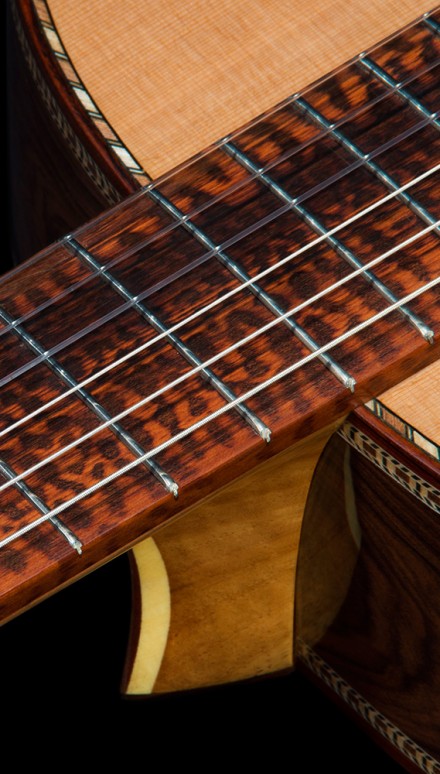 There are several different strains of "rosewood" out there. For the money, granadillo is can fit the bill...as well as keep the bill cheaper... - Gloss: I accept advice, in principle polyurethaneThis is another one of those areas where opinions run wild in the streets. This is also the part where most DIY builders run into trouble. [rant]
A hard finish is only there to protect the wood from you and the environment it inhabits. What you use is always be a trade off between cost, benefit and expertise\facilities.
[/rant] I like a wiped poly on necks. Thin the poly 50\50 with mineral spirits and wipe it. Levels very well and leaves a nice thin coat. Use a matte\semi-gloss on the back of the neck and it will feel much faster. I like lacquer on the body. It's still cheap, easy to spray, levels very well, leaves a thin coat and shines up better than any other finish for the money. Finish repairs are easier, as lacquer melts into previous coats, so no "look at me" ugly spots as can be seen in many a thick catalyst finish repair. Funny, Cygnus X-1 was the first Rush song I learned...I remember having hair back then... As you "go through the void" on this project, I would suggest a lot of research. Not just on building, but on a luthier\builder in your area. Doing this over the phone or Internet is going to remove the one thing you want from the process...that being exactly what you want from this process... They'll also want to hang onto your Carvin for a while to grab dimensions...or they should ask for it. Run from anyone who doesn't. If I glossed over something, or under-explained it, feel free to shout out. Happy Trails Cynical1 |
|
gerinski
Apprentice Shielder
 
Posts: 45
Likes: 11
|
Post by gerinski on Jul 14, 2023 5:06:26 GMT -5
Thanks a lot Cynical1 for all your advice! Some comments:
I'm already meeting most if not all luthiers in my area, and I have always taken my Carvin along to show it to them. Of course the selected one will be able to use my Carvin to take any measurements / templates he may need.
Most work with CNC, a few of them work freehand. In general the comments are, CNC is great for making a series of equal guitars, but for a unique piece it may take longer to make the 3D design than actually building freehand, although of course CNC simplifies a lot the building. I don't know if you agree.
I'm almost 100% convinced to contract a luthier, besides the risk of self-building, indeed the availability of the proper tools is a big handicap. It's a pity to buy a lot of tools only to use them once.
I guess the final choice of woods will also somehow depend on the luthier's opinions and supply sources. I'm afraid here in Europe we don't have the choice of woods for guitar building as they have in the States.
Frets material: I understand that stainless steel is very hard for working with. I will consider other meterials. At any rate what I don't want are golden frets, I want "steel colour" frets.
Zero fret & nut: I had not thought of a roller nut. This may be a nice solution which would make the zero fret unnecessary and avoid the nut wear due to tremolo operation (I often play with 09's and my graphite nut has had to be replaced already twice due to wear).
I have another question about the neck & truss rod. I know that currently several guitars use, besides the truss rod, two rods of titanium or graphite to help the neck stability. Do you recommend using them?
And may I ask what's the difference between a single action or a dual action truss rod?
Thanks again,
|
|
|
|
Post by cynical1 on Jul 14, 2023 8:03:27 GMT -5
If you can convert your drawing to verticies that a CNC router can interpret, life is good. It's all the screwing around trying to generate the model...or fixing a corrupted one...that eats up the time. Time costs more than wood...
There is a considerable investment in time building the templates and fixtures to build a guitar. The wood is cheap by comparison.
Depending where you are in Europe you have some very nice choices to build a guitar out of. Remember, Leo picked ash and maple to build his guitars because it was cheap and available in the US. There was no mojo harmed in the selection process. REPEAT, there was no mojo.
You have European or black alder, beech, birch, maple, walnut...not to mention all the exotic imported stuff you pay a left testicle for... Quiz your luthier.
Truss rods. Here's a master class topic for a forum post...
Basically, a single action truss rod only removes the bow, or counteracts the string pull...unidirectional. Dual-action truss rods can remove bow and backbow. Unless you live in a humid climate, a single action rod is probably sufficient.
Single action truss rods require less material to be removed when building, so if you like a thin neck profile a dual action rod may be too big to fit comfortably. Ask anyone with a Rickenbacker bass how they like a thin neck and dual action truss rod... Just don't mention the Rick bridge, though...that tends to induce a trauma response...
There are hybrid versions out there, but that's the Cliff Notes.
As far as the additional titanium, carbon fiber or graphite stiffener rods...unless you're going more than 6 strings on a guitar or 4 strings on a bass...or use excessively heavy string gauges it's probably not necessary. Again, more material is removed and less wood is left in the neck.
Typically the impregnated nuts are softer than the standard Tusq nuts. It's a trade off to reduce the friction at the nut when whammying. Roller nuts never took off, as they're a pain in the @ss to retrofit, but of you're building from scratch it's much less agony. Don't go cheap on your selection, as they tend to be proprietary in their designs, so refitting another one later re-introduces the aforementioned pain in the @ss...
HTC1
|
|
gerinski
Apprentice Shielder
 
Posts: 45
Likes: 11
|
Post by gerinski on Jul 14, 2023 12:30:58 GMT -5
Thanks a lot cynical1. All the advice and info is very appreciated and highly valuable. I guess the next step will be selecting a luthier and going through each point with him/her, and now I feel better prepared for doing so. I guess the opinions of the selected luthier will have some weight too in the final decisions. One of them already told me "I'm not building this guitar, it's not my style" (he is mostly building Tele-style guitars with some differences such as humbucker bridge pickup). At any rate I still welcome any advice or further information which can help me in this project! Regarding roller nuts, I see there are mainly 2 designs: Fender LSR roller nut, using ball bearings, individual for each string: 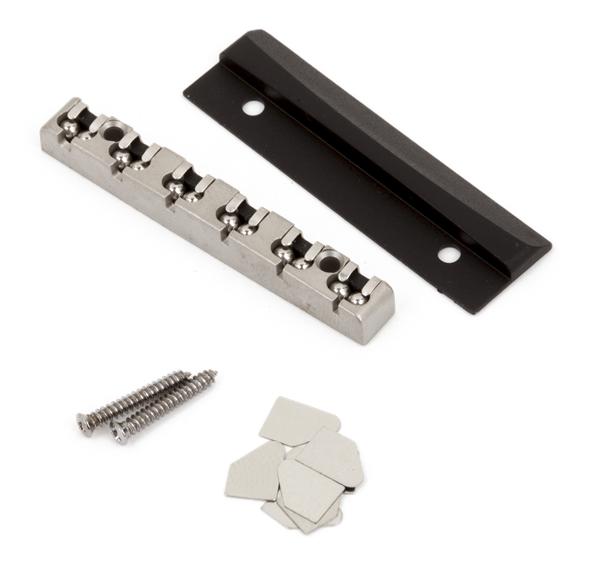 Roller nut with 3 rollers, one for each pair of strings: 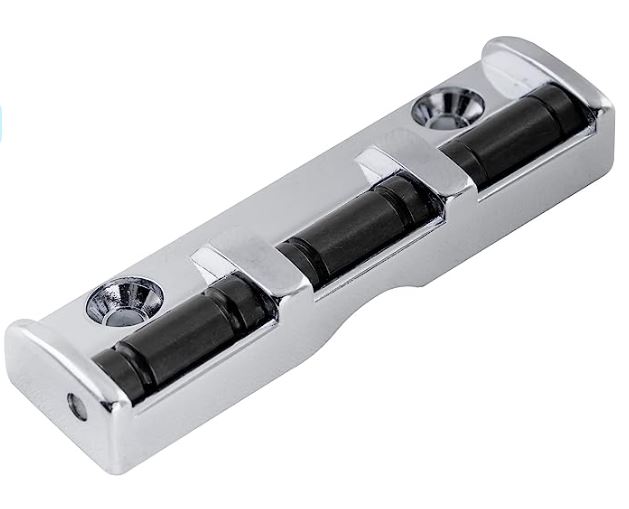 Possibly there's no huge difference but in principle I'd say that the roller bearing design should offer less friction and a smoother operation, right? |
|
|
|
Post by unreg on Jul 14, 2023 17:30:04 GMT -5
Hmm… I also imagine the second non-ball-bearing roller design will offer smoother operation, but a Floyd Rose guitar’s tuners aren’t adjusted very much. You get a great tuning and that tuning stays. If you feel the need to make small tuning adjustments, those can be done at the Floyd Rose. When you change the strings, that will be nearly the only time the roller nut will be used/rolled, imo. —- When your guitar is complete, if you choose The Schaller, and if you want help setting intonation, be sure to grab the PickPocket. The Key doesn’t work with my Schaller’s different shaped string-stopper-screw heads, at least. EDIT: I’m under the impression that a Floyd Rose can’t be fully used without a locking nut. But, cynical1 knows tons and he’d only recommend a roller nut to a Floyd Rose guitar if it would work. So, I guess a roller nut will work fine with a Floyd Rose as long as you don’t use the Floyd’s arm much? FINAL-REALLY-LATE-EDIT: Ah, maybe he’s recommending a roller nut instead of the Floyd Rose. |
|
|
|
Post by thetragichero on Jul 14, 2023 18:55:36 GMT -5
I've finished a number of instruments with waterbased poly stemming from a luthier on the talkbass forum (he makes a version of the ampeg "scroll bass"). i like it because it can be sprayed on pretty thick before it runs, and the no VOCs is a benefit (I've burned enough brain cells playing in punk bands for ~25 years so whatever is left is precious). I've also successfully mixed aniline dye with a bit of denatured alcohol (since the dyes are powder) and then into the poly. between dying the wood and dye in the poly it seems to give a nice depth of color
i like the idea of the output jack cutout but feel it would fit better if it were curved instead of square. it's a good spot and allows for wrapping the cable over the back of the strap so that it doesn't come out on the midst of wild flagellations
|
|
gerinski
Apprentice Shielder
 
Posts: 45
Likes: 11
|
Post by gerinski on Jul 15, 2023 1:49:31 GMT -5
i like the idea of the output jack cutout but feel it would fit better if it were curved instead of square. it's a good spot and allows for wrapping the cable over the back of the strap so that it doesn't come out on the midst of wild flagellations Thanks thetragichero! What do you mean by the jack cutout being curved instread of square? |
|
|
|
Post by gckelloch on Jul 15, 2023 1:58:31 GMT -5
Less body wood will make it more likely to be neck heavy when sitting. The wood in the centerline is what matters for sustain. A 5-piece Maple/Mahog (or Walnut) neck-thru should be very stable. Might be worth getting Roasted-Maple if it's not much more money. You might want something heavy for the wings, like Ash, to minimize neck dive. Again, the wing wood shouldn't make much difference in damping characteristics. BTW, the Roasted-Poplar wings on my custom hardtail S-type is a much darker shade than the black walnut center. I wasn't expecting that, but I think it looks better than way. You might consider getting the frets & nut Plek'd with the Stainless frets. It will be "perfect" and may never need any fretwork depending on your string choice and playing style.
That snakewood FB looks awesome. Some say the FB wood doesn't matter to the tone, but that has not been my experience. It affects damping at least as much as any wood in the guitar. I find Indian RW to damp higher freqs, but has at least as much midrange and 2~4kHz clarity as Hard Maple. I'd avoid woods like birdseye, ambrosia, or spalted Maple that can sap highs or allow fret sprout. Stainless frets tend to give the tone more "zing" anyway. Not sure how the FB wood would affect that. My baritone Roasted-Maple neck w/Pau Ferro FB and Stainless frets has a bright response for sure. Pau Ferro generally damps less highs than Indian RW. You might look into a figured Ziricote FB. It's generally between those two woods tonally, and the dark wavey grain looks really nice. I think it would look really nice with Torqouise dots, but anything goes with black. I chose Jade stone dots for my baritone neck. It's very nice, but a bit dark.
Thinner strings have more highs, but can also have a less strident attack. The 9-42 Ni/Fe alloy set on my Parker Nitefly definitely soften the attack character of the carbon/glass fibre FB w/Stainless frets compared to heavier guages. Some plain strings of the same gauge also sound "sweeter" than others. I guess it depends on the Steel alloy used and the thickness of the Ni-plating. Stainless Steel strings might be the harshest. Sfarzo claims to use Swedish steel. All I know is the plain strings sound warmer/sweeter than the cheap bulk (Chinese) ones I have. Other brands likely have better Steel as well. I haven't compared them to D'Addario XL's.
|
|
gerinski
Apprentice Shielder
 
Posts: 45
Likes: 11
|
Post by gerinski on Jul 15, 2023 2:29:49 GMT -5
Thank you gckelloch, all that advice regarding the woods is so much appreciated!
My idea is to have a translucent colour finish but I don't mind the wings looking different than the center piece, in my Carvin the difference is also very noticeable (maple center and poplar wings) and to me it looks nice.
Sorry what do you mean by "You might consider getting the frets & nut Plek'd with the Stainless frets"? I'm not a native English speaker and I don't understand the sentence.
TBH I don't like that snakewood FB, it's a matter of personal taste.
As for the strings, I often use 09-46.
|
|
|
|
Post by kitwn on Jul 15, 2023 2:35:18 GMT -5
I'm all in favour of having a go at building it yourself, but the tooling up is an issue. If you know someone who already makes guitars as a hobby they may be willing to help out. I have only made one guitar so far ( the one in my picture) and so am not exactly qualified to give expert advice but a couple of points come to mind based on other people's designs:
Getting a dead straight string run from the nut to the machines can help with stable tuning, especially with a trem if you don't have a locking nut. Your design looks as if you're close to getting that but many machines won't fit in the space available for the D and G strings. An offset as in the PRS standard head works, though PRS string's aren't exactly straight from the nut.
As you have commented, wear on a zero fret is a problem as the strings are always in contact with it during tuning. Make the zero fret stainless even if the others are not.
I like the original jack socket position but it will only be protected if the full length of the plug and cable strain-relief is within the body outline. Otherwise you're probably just as prone to damage as with an LP or Tele design.
Have fun with it!!!
Kit
|
|
gerinski
Apprentice Shielder
 
Posts: 45
Likes: 11
|
Post by gerinski on Jul 15, 2023 3:01:02 GMT -5
Thanks kitwn!
Indeed the idea is to have all the strings run as straight as possible from nut to machine head. I'm not sure if that will be 100% possible with the Sperzel Trim-Lok tuners in 3+3 layout, but I would try as close as possible to straight.
As for the zero fret, I'm seriouly considering a roller nut instead.
|
|
gerinski
Apprentice Shielder
 
Posts: 45
Likes: 11
|
Post by gerinski on Jul 15, 2023 3:24:55 GMT -5
Thanks unreg!
That PickPocket tool looks really useful for setting the intonation in the trem bridge!
|
|
|
|
Post by gckelloch on Jul 15, 2023 3:39:03 GMT -5
Plek is a machine-aided fret and nut leveling/cutting/polishing service that is more accurate than a human. It's ~$300 for both tasks in the states, and ~$250 for just the frets. Not sure if you can get it where you are.
|
|
gerinski
Apprentice Shielder
 
Posts: 45
Likes: 11
|
Post by gerinski on Jul 15, 2023 3:49:01 GMT -5
Plek is a machine-aided fret and nut leveling/cutting/polishing service that is more accurate than a human. It's ~$300 for both tasks in the states, and ~$250 for just the frets. Not sure if you can get it where you are. Thanks, I see... I never heard of it, I will check it out. |
|
|
|
Post by cynical1 on Jul 15, 2023 7:43:50 GMT -5
Fender LSR roller nut. Everything else is a thin shadow to it. You do have to clear out 3/32", as I recall, from in front of your traditional nut slot\shelf to fit it, but since you're not the one fitting it, your luthier should be able to knock in out in short order. It does marry you to the LSR, as your nut slot is now about 3/32" (2. something millimeters) shorter than scale...but no on ever asked me to rip one out for a bone nut...so there's that... If you can find a PLEK machine over there they are amazing...and it's not that much more expensive than a manual fret leveling\re-crown job. It is certainly more precise. It makes perfect sense on a new guitar, especially with stainless frets. For reference: In regards to water based coatings or using water as a medium in dyes for wood...there is one gotcha to using water. Using water can...and likely will...raise the grain on your wood after application. Solvent based good old V.O.C.'s (volatile organic compound) products will not raise the grain. Granted, you have to work fast, or just spray the dye using denatured alcohol as the alcohol evaporates quickly...but it never raises the grain. The only exception to that rule is if I'm doing a two stage dye job on a quilted maple. I would mix the first coat, typically black, with water. After it dried it was easier sanding it flat and creating the gradient I wanted, so the color coat would make it pop...and the color coat was always mixed with denatured alcohol. You get this effect from the process:  Granted, traditional v.o.c. products do bring some baggage. At my age, though, I doubt that's what's gonna kill me. A good mask is less that your deductible for an E.R. visit, so there's that... I have one like this, but I used to do a lot of this stuff:  With the neck-through design, you can still top the guitar. My personal favorite it anything quilted. Maple is the common choice, but not the only one I've seen. Anything with a pronounced burl can be sexy. Just fill the inherent voids with epoxy...which you can also color if you desire. Carve the top...drop some binding in there...pretty... I mention this, of course, as none of this is my money... Out of curiosity, what wood selections do builders recommend in Europe these days? HTC1 |
|
gerinski
Apprentice Shielder
 
Posts: 45
Likes: 11
|
Post by gerinski on Jul 15, 2023 8:52:01 GMT -5
Fender LSR roller nut. (...) It does marry you to the LSR, as your nut slot is now about 3/32" (2. something millimeters) shorter than scale...but no on ever asked me to rip one out for a bone nut...so there's that... Yes you're right, even if I guess a Fender LSR roller nut should last a lifetime, I must take this into consideration... Difficult choice... - Standard way, no zero fret + graphite nut - Stainless steel zero fret + graphite nut - Fender LSR roller nut - Locking nut Most of the luthiers I have visited so far recommended for the neck-through maple, alder, ash, mahogany... but the subject was left open to further discussion. |
|
gerinski
Apprentice Shielder
 
Posts: 45
Likes: 11
|
Post by gerinski on Jul 26, 2023 15:38:39 GMT -5
Well I already selected the luthier and I made a downpayment to order the hardware.
The updated specs are:
- Neck-through construction
- 25.00" scale
- 24 frets, in principle in stainless steel but not yet 100% decided
- Neck-through wood: maple, 3-piece laminated
- Body wings wood: tbc
- Fretboard wood: ebony
- Fretboard radius: 12"
- Dual-Action truss-rod
- Titanium neck stiffener rods
- 3+3 headstock, straight string pull nut to machine heads
- Zero fret, probably in stainless steel
- Graphite nut
- Sperzel Trim-Lok machine heads
- Original Floyd Rose tremolo bridge
- Pickups: HSH, EMG active
Bridge: EMG 57 TW, Middle: EMG SA, Neck: EMG 66 TW (the TW series are the humbuckers which can also function in Split Coil mode)
- Integrated "Lo-Bat" low-battery indicator (possibly, not yet 100% decided)
- Controls: 3 mini-toggle switches, one for each pickup. Bridge: 3-position Off / Single-Coil / Humbucker; Middle: 2-position Off / On; Neck: 3-position Off / Single-Coil / Humbucker
1 master volume + 1 master tone. Knob position markers.
- Housing for 2 batteries, there may be an additional toggle-switch to select 9 or 18v operation but not yet decided
- Colour: translucent grey including neck and headstock. All hardware in black.
- Finish gloss: Polyurethane
Now the luthier will order the hardware and we will all go to some deserved summer vacation, and I hope that he can start beginning of September.
Some things will be done with CNC, so the first thing will be to develop my computer 2D design (which I made with Inkscape) into a 3D design made in AutoCAD.
|
|
gerinski
Apprentice Shielder
 
Posts: 45
Likes: 11
|
Post by gerinski on Nov 7, 2023 19:14:58 GMT -5
|
|
gerinski
Apprentice Shielder
 
Posts: 45
Likes: 11
|
Post by gerinski on Nov 7, 2023 19:16:23 GMT -5
|
|
|
|
Post by newey on Nov 7, 2023 19:56:20 GMT -5
Looking very nice, gerinski! What is the fretboard wood? Is that the snakewood? Also with EMG actives (and this comes under the heading of a Homer Simpson "Doh!" moment if you forget . . .) when planning the cavity layout, make sure you have a spot to put the battery! You were talking about using DiMarzios in the original description above, so if it is to be actives, plan accordingly. |
|
gerinski
Apprentice Shielder
 
Posts: 45
Likes: 11
|
Post by gerinski on Nov 8, 2023 5:33:58 GMT -5
Looking very nice, gerinski! What is the fretboard wood? Is that the snakewood? Also with EMG actives (and this comes under the heading of a Homer Simpson "Doh!" moment if you forget . . .) when planning the cavity layout, make sure you have a spot to put the battery! You were talking about using DiMarzios in the original description above, so if it is to be actives, plan accordingly. Thanks newey! The fretboard is ebony but it's a piece with a very marked grain. We have already planned the battery cavity, it will accomodate 2 9v batteries so I will have the option to use 9v or 18v, switching the wiring between the 2 options seems to be very simple (so the luthier told me) and can be done at the very end after testing how both options sound. It will be located in the upper wing, above the strings, we did not want to weaken the central neck-through piece any more (e.g. behind the bridge), and the lower wing is already too busy with the switches, potentiometers and the output jack. |
|
|
|
Post by pyrroz on Nov 20, 2023 9:23:31 GMT -5
wow man, you did it!
|
|
gerinski
Apprentice Shielder
 
Posts: 45
Likes: 11
|
Post by gerinski on Dec 2, 2023 19:27:15 GMT -5
Well not yet done, but it's underway yes! |
|
gerinski
Apprentice Shielder
 
Posts: 45
Likes: 11
|
Post by gerinski on Dec 19, 2023 14:56:50 GMT -5
The guitar keeps advancing, the cavities are all made, the fretboard has been attached to the neck, the neck is getting its shape, the headstock is almost done... now the body is being contoured   |
|
|
|
Post by cynical1 on Dec 21, 2023 13:11:21 GMT -5
Very pretty
|
|
gerinski
Apprentice Shielder
 
Posts: 45
Likes: 11
|
Post by gerinski on Dec 21, 2023 15:39:51 GMT -5
Thanks! Yes, so far I'm pleased with the progress. |
|
























